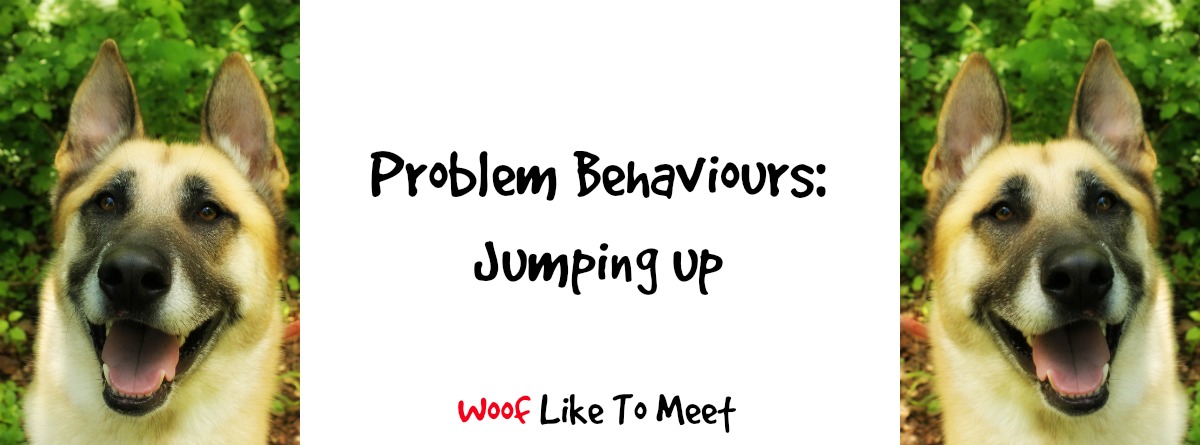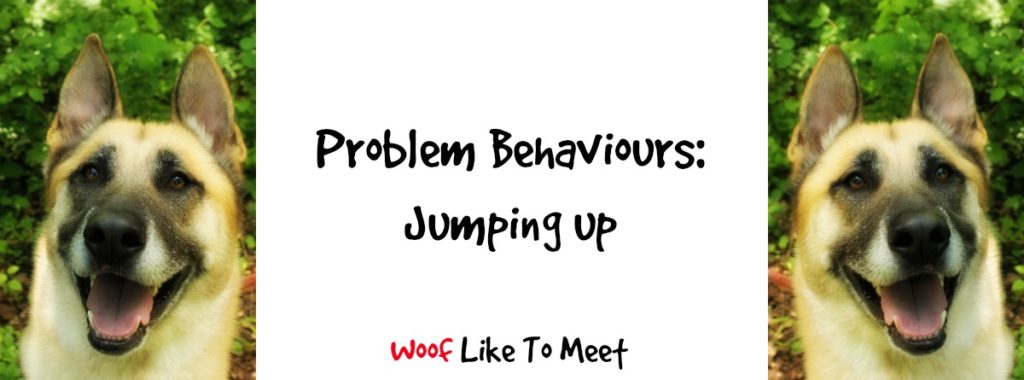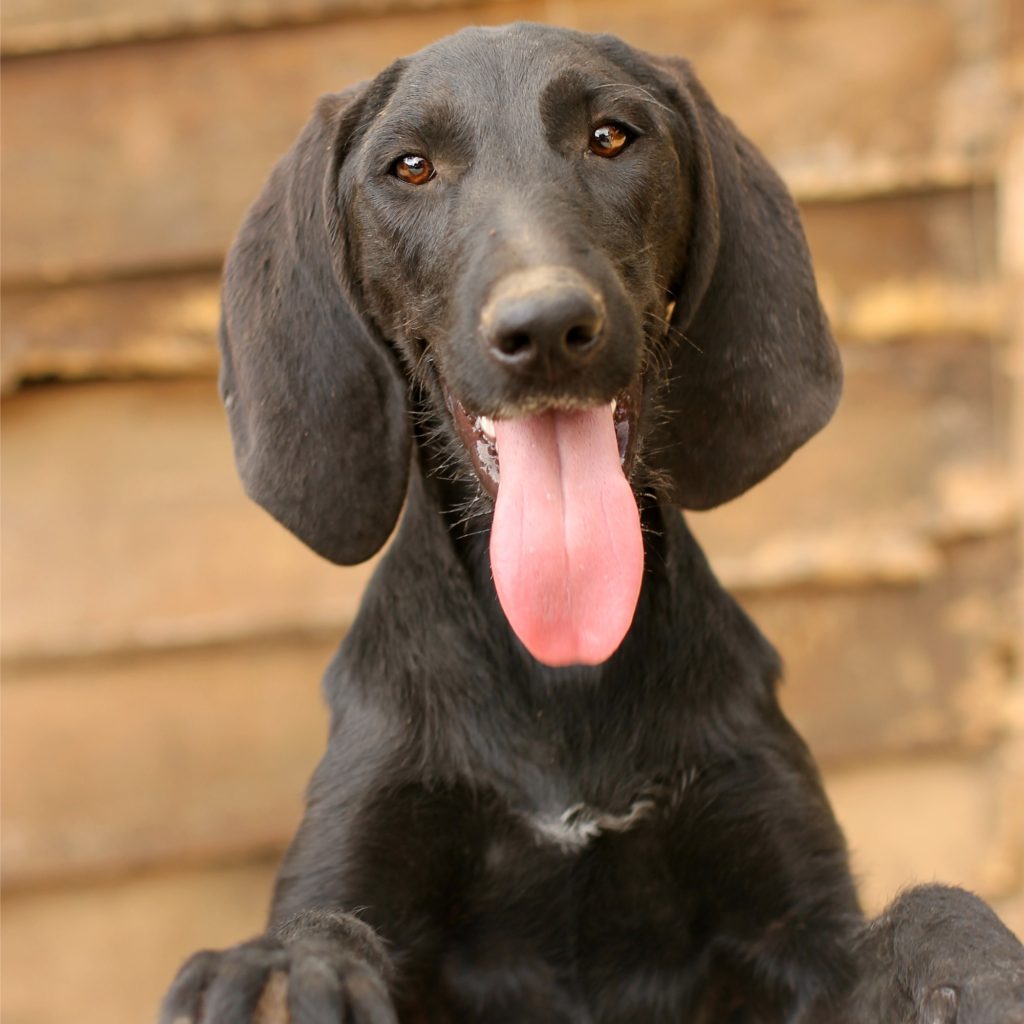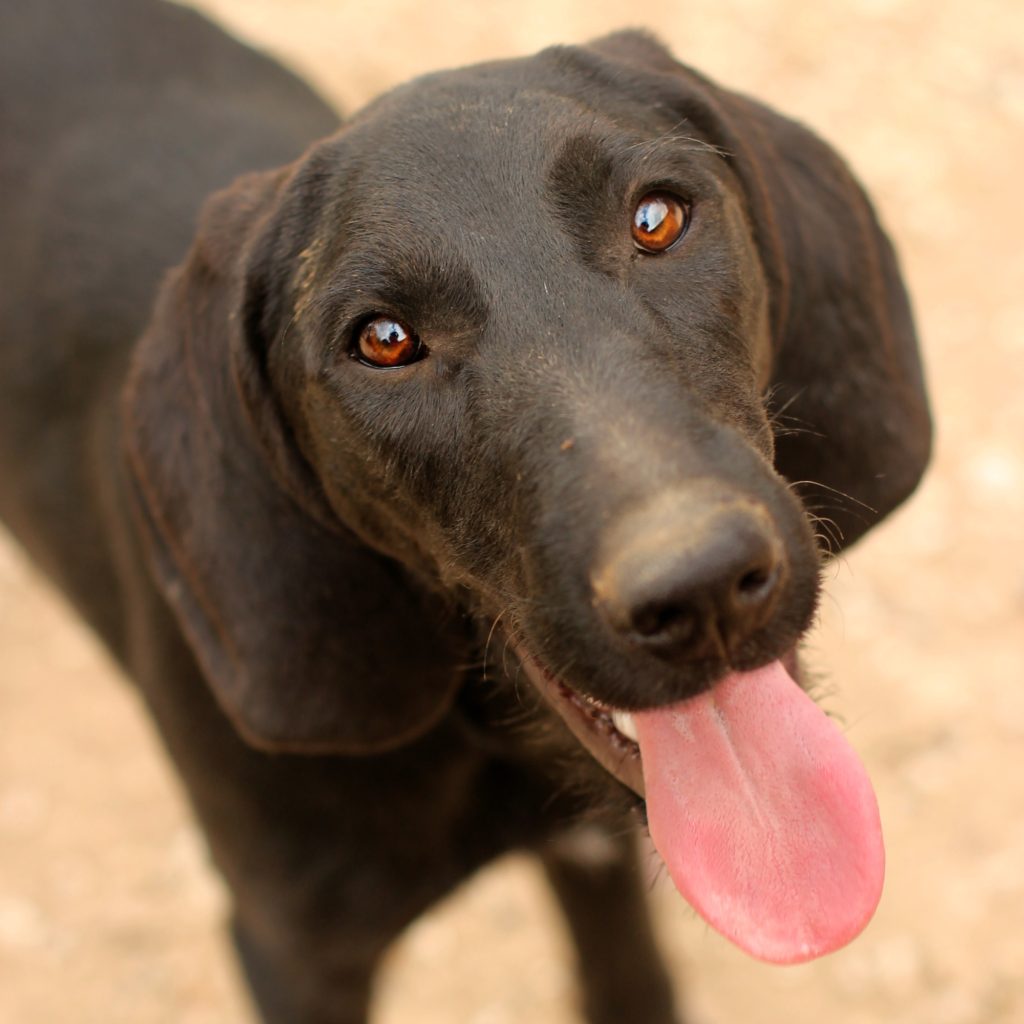You may be wondering what this handsome guy has to do with jumping up…. if I tell you his name is Jump, does that give you a clue? I’m pretty sure that he’s one of the dogs who made it on to the top of the kennel blocks, but I could be mistaken. I’m sure that’d give rise to a name that states the obvious!
Jumping up is a behaviour that has many rewards for a dog, which is why it can be one of the hardest behaviours to eliminate. That said, it’s a problem with a lot of solutions that I’ll discuss here today. Only you will know which one will be most effective with your own dog. It may take a few weeks or even a few months to really get a consistent ‘no-jump’ greeting, so you’re going to need to stick at it. To understand why it can take some time to eliminate, you need to understand a few reasons why dogs might jump in the first place.
Whilst dogs might not naturally go for hugs with another dog when they first meet, face to face is perfectly normal. It’s usually face before butt for most dogs who greet each other. A butt sniff tells you a lot of stuff about another dog, but a face sniff is less intrusive and much more polite. In a 20-way dog greeting between 20 unfamiliar dogs, every single one went face-first. Smelling the corners of mouths is a standard behaviour. And you know what they did then? Played chase, peed, sniffed stuff. Some of them, yes, even jump on each other. If you watch a lot of dog interactions, there’s this burst of play energy, and jumping up is a natural way to express that energy too. Nose-to-nose interactions are so frequent, even among very familiar dogs.
And that’s easy if you’re a dog. Getting your schnozzer near their mouth is the main aim, and most social dogs will cooperate by lowering their heads to greet a smaller dog, or raising their heads to greet a bigger dog.
Bit difficult though when it comes to interspecies greetings… when you’re all the way UP HERE and they’re all the way DOWN THERE. And if you’re not bending down, a dog will make its own solution. Whoo hoo! I want to see your face and show you how glad I am to see you… and jumping on you just gave me exactly what I wanted.
Some people encourage jumping as well. A face-to-face, chest-to-chest greeting is a pretty chimpy-biped kind of thing to do. It makes us feel welcomed and it makes us feel happy. We like to see excited dogs. We don’t want to get down on the floor in the dirt to let the dog greet us at their level, but we want to say hi. It feels kind of vulnerable to get down there, and we know we can always push an exuberant dog off or unbalance them if they’re on two feet, which we can’t do if they’re crouching.
Plus, dogs, like humans, are excited at greeting times. We aren’t cats, sullenly spying on each other from a distance or putting plenty of space between us until we feel comfortable with a stranger. Dogs get excited meeting each other, meeting strange dogs, and they get excited meeting us. I watch an enormous amount of dog-human greetings, and dollars to donuts, dog people go right in to greet a dog way before they greet the person behind them. So we blame the dogs when, guess what, we’re responsible for encouraging the behaviour in the first place. Not only that, every time a dog does it, it feels blummin brilliant to them. It’s great to get unconditional love and excitement from a human chimpy person. A lot of dogs have learned that the reward for jumping is a real feel-good factor. The more they do it, the more they get out of it. Hence the fact your dog might turn into Zebedee… or your 60kg Newfie bowls you over.
A last reason your dog might be leaping up to see you is an appeasement behaviour. If they’re trying to lick your mouth, it can be a way of showing you they feel a bit stressed about your relationship, and they’re trying to calm you or appease you. It’s a behaviour that puppies do with older dogs to show that they’re not a threat. This type of jumping up definitely requires a gentle, force-free approach, since your dog could already be nervous about your relationship.
That’s the why.
But you don’t care about that, if you’re reading this. You just want to teach them not to. Or when to and when not to. It’s not an ‘either/or’. If you want them never to jump, that’s your prerogative. If you would rather they waited until asked and didn’t bowl over small children whilst still being able to give you a nice greeting, that’s your prerogative too. However, not everyone likes dogs to jump on them, even little 5kg chihuahuas, so it’s important that you teach your dog when it’s appropriate to jump.
There are several strategies you can use to deal with jumping up. All of them have positives or situations when they might be more appropriate, but there are some consequences to the simplest techniques, as you would expect. There are those who give a knee to the chest (which unbalances you and can leave you flat on your arse) or another punishment, verbal or physical. These can be effective, but by and large, people who contact me with a jumper who’ve used these techniques tell me that they never worked or they no longer work.
Don’t forget that what a dog wants is attention from you. It doesn’t care if that’s angry attention or happy attention. My foster dog Feff makes that clear when he wakes me up at 5am and I grumble at him to get back to bed. My “Ferfeck’s sake Feff, it’s 5am!” might as well be “Hello my wonderful and delightful fosteree… how glad I am to see you! Thank you for waking me up at 5am – it’s the early bird that catches the worm after all!”
Manage the environment
One strategy is to manage the environment. If your dog is a coiled spring when you or when visitors arrive, putting them on leash or putting them in a crate until the excitement has dissipated is a great way to do that. A leash allows an owner to control the dog effectively with guests. You aren’t going to use it to pull your dog off, just to put distance between the dog and a guest. Using a leash is pretty ineffective if YOU’RE the person the dog jumps on, unless you’re working with a partner who’s got hold of the leash.
Using a leash means that your dog will need supervision at all times around guests until their behaviour is rock solid (though you can use longer and longer lines). It can also be frustrating for a dog to do it this way if they are leash-reactive or they get excited around a leash. If I stuck a leash on Heston every time a guest arrived, he’d get more excited because a leash is exciting in itself.
Also, because he is then restricted from getting to the person, it can cause a reactive dog to react more, or even become fearful. However, it stops the dog jumping and stops them getting a kick out of the behaviour. A crate can do the same thing, as can a closed door. Keeping the dog away from visitors until all that greeting energy has dissipated is a good strategy, but bear in mind that it can be frustrating and even amp up a dog’s energy.
In this case, it’s you controlling the dog’s behaviour rather than the dog learning not to do the behaviour from the inside out, so it’s less effective than learning that comes from the dog itself. If they want attention and affection, you want THEM to think, ‘Well, that didn’t work… what else can I try?’
This is a great technique to use, though, if you have guests who may not always listen to you about the next strategy. It’s an emergency strategy for me with a jumping dog who hasn’t yet got a 100% jump-free greeting. You can also use a leash to help with teaching incompatible behaviours or using a ‘stooge’ guest.
I would never use a leash to stop a dog jumping if the dog has poor bite inhibition and/or frustration on a leash. What you are effectively doing is making it impossible for the dog to move away. Where I’ve seen instructors on Youtube using a leash, it’s with a dog who’s pretty much under control anyway. The last thing you want is to frustrate a dog with poor bite inhibition who then turns around and sinks their teeth into you. I’d prefer to keep this dog away from all excitement with a secure crate or a different room until the excitement has dissipated. With a dog like this, you need to take commands right back to the very basics: sitting where there are no distractions and when the dog is super-calm.
Manage your body language
The second strategy is also very effective… simply using your body. If you read Turid Rugaas’s excellent book Calming Signals, there are a few calming signals you can easily use that will quickly teach a dog not to jump.
One of these is to cross your arms and turn your back, moving away from the dog if the dog is on a leash too. This is a great one for children to learn around over-excited dogs. Turn to stone and stop flapping arms. Stop looking at the dog and interacting with it. Turn your head away from the dog and do not get eye contact. Hold this for several seconds at least. Turn your body away from the dog, either at 90° or 180°. Move very slowly and lower your energy levels.
This is a strategy I use all the time with shelter dogs when I have to enter their enclosures alone to get photos. Most of the time, I photograph dogs on leash as the volunteers can then keep them under control. I’ve got a lot of expensive equipment that I don’t want them to damage. Going into an enclosure alone with this equipment is a big risk if the dog is excited to see me. Even with hardened jumper-uppers, this has worked like a charm. Took me two minutes yesterday with a scratchy little terrier who was doing the Dog Dance of Delight, gave up and then sat down, looking at me! You have no idea how effective it is and how quick. It’s like she thought, ‘Ok… that’s not worked. I wonder if this will?’
This technique has only failed me once and allowed me to effectively stop dogs jumping up at me thousands of times. If I want a photo of a bouncy, off-leash dog in less than five minutes, this works like a dream. It even works with excited puppies and bouncy Newfies.
On this particular day, Megane was in with five other big puppies, including a nipper. They were all very excited to see me. Here, I’m using a kennel between us, but you can see she wants to see me at eye level and she’s up on the kennel.
And here you can see she is off-lead, feet on floor, slightly to an angle. There are less than 5 minutes between the two shots. Your body language is by far the best way to manage jumping up. You can sometimes speed the behaviour up by rewarding “four feet” but to be honest, I find this is only useful when it is NOT a greeting jump. A reward like food or a toy can sometimes amp up the excitement, and possibly the jumping. With my ex-jumper, he’s not interested in food at a greeting. What he wants is attention and to greet me. I reward him with that only because he is not interested in food at that point. Here, I’m letting the behaviour reward the dog, not a reward in itself. But you might find that could work with your dog if they’re not quite as excited.
A side-effect of using your body is that it’s very hard to get guests, visitors and strangers to do this, and I feel that it’s also a bit of a knock-back for the dog. All it takes is for one guest to ignore your advice and you’ll be back to square one. I think it’s important that the owner continue to make reassuring noises and to praise the dog copiously for “four feet”, and that the guest greets the dog as soon as the energy has dissipated, turning away again or turning to stone if the dog starts jumping up again. I find that it can also be a little less effective with small dogs who dance on hind legs, because they can’t see your face anyway and are used to jumping up to legs, whichever way they point.
You may also find that dogs try it more for a little while before giving up completely. If it seems to be working and then it wasn’t, persevere! This is known as an extinction burst and often happens before someone gives up altogether. Like me pressing CTRL+ALT+DEL a hundred times when my computer freezes before giving up.
The only dog this didn’t work on? A beauceron x setter, Jack. He got both his paws over my turned back and started humping me against the bars of the enclosure. I was just his prison bitch. Actually, turning around and telling him to sit worked much better! But that is the only time that happened, promise!
Teach the response you want
If you want your dog to do something other than jump up, you can use a clicker or a word such as “Yes!”
This is a great technique using a treat on the floor to help direct the dog’s behaviour. You can’t eat a treat off the floor if you are jumping on your owner! Here’s Emily from Kikopup demonstrating. Don’t be put off – this works just as well with adult dogs. By the way, when shelter jumpers Hagrid and Jack are a bit exuberant, I’ll wait until they’re not jumping and put a few treats on the floor. The reason I use more than one is that because by the time they’ve searched in the grass for a treat, the urge to jump for joy is gone. The floor treats distract them from jumping on you.
I love this technique because it doesn’t require you to control the dog with the leash. It also doesn’t rely on you calming them with your body (although you’ll notice Emily doing it a little when she’s initially teaching the behaviour). It teaches them that you can have a lot of energy and still keep four feet on the floor. I especially like the part of the video where she is proofing the behaviour, adding in the toy and the squealing retreat, both of which it’s important to teach your dog. I taught Heston this way using his favourite toys at the end to really ensure it was rock solid. Remember your 3Ds and put plenty of distance between you and your guests at first (I use ‘stooge’ guests) as well as asking for the behaviour for a short duration, and making sure that there are no other distractions. You can make it closer and ask for longer behaviours as you go on, including more distracting situations, but less is definitely more. Stop whilst your dog is successful and never ask for too much.
It does take some time to do, which is fine, but it doesn’t always prepare your dogs for guests who might encourage them to jump up, so I’d also teach them when to and how to jump up and manage the environment with guests who were causing the behaviour rather than eliminating it. This isn’t a good technique to start with if you haven’t taught sit as a very minimum. Don’t forget to phase out the treats!
Teaching an incompatible behaviour
I’m a firm believer of teaching incompatible behaviours. Some people ask a dog to sit rather than jumping, but sit can be a good base for a jump, so a ‘down’ is a better position to stop the springing. You can see that in the Kikopup video too. You’ll see the puppy offering a down and a sit, which is often what dogs do to test out what you prefer. Putting a verbal cue or gesture in there is also important and something not done on the Kikopup video. “Four feet” is a good one.
I also like to teach the behaviour itself and put it on cue. Heston very, very rarely jumps these days, and mostly it’s because it’s a cued behaviour. I ask him to jump and he does. Here, I use a gesture and a verbal cue. I pat my chest, say “Up!” and put out my arms as the cue to jump, he jumps, rests on my arms, and I bend forward for a nose-to-nose greeting. Again, it’s a behaviour that is intrinsically rewarding in itself, so you may not find you need to use much by way of treats. What I get is a really nice, steady jump with his paws in my hands.
There will, no doubt, be people who think that it’s not good for a dog to be on its hind legs, and it isn’t, not for prolonged periods, or if your dog has problems. But if your dog is doing it anyway, putting it on cue means that you can ask occasionally for them to do it, if they look like they might, and all the other times, they just don’t do it. Heston only ever jumps on me when I pat my chest and say “Up!” – and I maybe ask for that behaviour once every month or so.
If jumping is a behaviour your dog really, really enjoys, it’s worth using it as a reward for an incompatible behaviour. Thus, if I’ve had a calm greeting, I’ll sometimes ‘reward’ Heston by asking him to jump. I only do this when he’s got his emotions under control though. That way, I get a lovely, gentle “Up!” and none of the full frontal savagery. This technique is not one to do if your dog seems at all stressed, if they are desperate to greet you because they’re suffering from separation anxiety, or if they are a face-mugger. By the way, this video below is what I’m working with Mr Hagrid, mouthy shelter Mali, as he mugged my face (with some level of terror on my behalf) when I bent down to tie my shoelace.
It’s also worth considering two other things: the age of your dog and their breed. Certain breeds do love the Doggie Dance of Delight more than others. If you know a toy poodle, you’ll know what I mean. And some dogs have bodies designed for off-road agility, for whom a little agility training or light frisbee (and I mean light!) might help channel their natural desire for air space. Young dogs are more likely to do this too since dogs need to be taught that it is not appropriate. The time to teach this is when they are a puppy, not leave it til their 2nd birthday and being jumped on by a 40kg shepherd is no longer any fun.
Between teaching them to keep four feet on the floor, teaching them an alternative behaviour, controlling how your dog greets guests and using body language to help you, you should find that issues with dogs jumping all over you is quickly resolved. There really is no need to use the ineffective knee to the chest, and you certainly don’t want to punish your dog or reprimand them for being pleased to see you. Hopefully one of these solutions will suit you perfectly.
In the next post, to come back to being Jack’s prison bitch, I’ll be tackling the socially embarrassing problem of humping and mounting!




